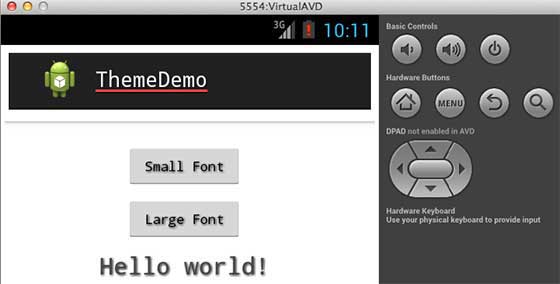Android - Theme Demo Example
Following example demonstrates how you can use a theme for an application. For demo purpose we will modify our default AppTheme wehere default text, its size, family, shadow etc will be changed. Let's start with creating a simple Android application as per the following steps −
| 步骤 | 描述 |
|---|---|
| 1 | You will use Eclipse IDE to create an Android application and name it as ThemeDemo under a package com.example.themedemo as explained in the Hello World Example chapter. |
| 2 | Modify src/MainActivity.java file to add click event listeners and handlers for the two buttons defined. |
| 3 | Define your style in global style file res/values/style.xml to define custom attributes for a button and change default theme of the application to play with the text. |
| 4 | Modify the detault content of res/layout/activity_main.xml file to include a set of Android UI controls and make use of the defined style. |
| 5 | Define required constants in res/values/strings.xml file |
| 6 | Run the application to launch Android emulator and verify the result of the changes done in the aplication. |
Following is the content of the modified main activity file src/com.example.themedemo/MainActivity.java. This file can include each of the fundamental lifecycle methods.
package com.example.themedemo;
import android.os.Bundle;
import android.app.Activity;
import android.view.Menu;
import android.view.View;
import android.widget.Button;
import android.widget.TextView;
public class MainActivity extends Activity {
@Override
protected void onCreate(Bundle savedInstanceState) {
super.onCreate(savedInstanceState);
setContentView(R.layout.activity_main);
//--- find both the buttons---
Button sButton = (Button) findViewById(R.id.button_s);
Button lButton = (Button) findViewById(R.id.button_l);
// -- register click event with first button ---
sButton.setOnClickListener(new View.OnClickListener() {
public void onClick(View v) {
// --- find the text view --
TextView txtView = (TextView) findViewById(R.id.text_id);
// -- change text size --
txtView.setTextSize(20);
}
});
// -- register click event with second button ---
lButton.setOnClickListener(new View.OnClickListener() {
public void onClick(View v) {
// --- find the text view --
TextView txtView = (TextView) findViewById(R.id.text_id);
// -- change text size --
txtView.setTextSize(24);
}
});
}
@Override
public boolean onCreateOptionsMenu(Menu menu) {
getMenuInflater().inflate(R.menu.main, menu);
return true;
}
}
Following will be the content of res/values/style.xml file which will have addition style CustomButtonStyle defined −
<resources>
<!--
Base application theme, dependent on API level. This theme is replaced
by AppBaseTheme from res/values-vXX/styles.xml on newer devices.
-->
<style name="AppBaseTheme" parent="android:Theme.Light">
<!--
Theme customizations available in newer API levels can go in
res/values-vXX/styles.xml, while customizations related to
backward-compatibility can go here.
-->
</style>
<!-- Application theme. -->
<style name="AppTheme" parent="AppBaseTheme">
<!-- All customizations that are NOT specific to a particular API-level can go here. -->
<item name="android:capitalize">characters</item>
<item name="android:typeface">monospace</item>
<item name="android:shadowDx">1.2</item>
<item name="android:shadowDy">1.2</item>
<item name="android:shadowRadius">2</item>
<item name="android:textColor">#494948</item>/>
<item name="android:gravity" >center</item>
<item name="android:layout_margin" >3dp</item>
<item name="android:textSize" >5pt</item>
<item name="android:shadowColor" >#000000</item>
</style>
<!-- Custom Style defined for the buttons. -->
<style name="CustomButtonStyle">
<item name="android:layout_width">100dp</item>
<item name="android:layout_height">38dp</item>
</style>
</resources>
以下是 res/layout/activity_main.xml 文件的内容 −
<?xml version="1.0" encoding="utf-8"?>
<LinearLayout xmlns:android="http://schemas.android.com/apk/res/android"
android:layout_width="fill_parent"
android:layout_height="fill_parent"
android:orientation="vertical" >
<Button
android:id="@+id/button_s"
style="@style/CustomButtonStyle"
android:text="@string/button_small"
android:onClick="doSmall"/>
<Button
android:id="@+id/button_l"
style="@style/CustomButtonStyle"
android:text="@string/button_large"
android:onClick="doLarge"/>
<TextView
android:id="@+id/text_id"
android:layout_width="wrap_content"
android:layout_height="wrap_content"
android:capitalize="characters"
android:text="@string/hello_world" />
</LinearLayout>
Following will be the content of res/values/strings.xml to define two new constants −
<?xml version="1.0" encoding="utf-8"?> <resources> <string name="app_name">ThemeDemo</string> <string name="action_settings">Settings</string> <string name="hello_world">Hello world!</string> <string name="button_small">Small Font</string> <string name="button_large">Large Font</string> </resources>
Following is the default content of AndroidManifest.xml. Here we do not need to change anything because we kept out theme name unchanged. But if you define fresh new theme or inherit a default them with different name then you will have to replace AppTheme name with the new them name.
<?xml version="1.0" encoding="utf-8"?>
<manifest xmlns:android="http://schemas.android.com/apk/res/android"
package="com.example.guidemo"
android:versionCode="1"
android:versionName="1.0" >
<uses-sdk
android:minSdkVersion="8"
android:targetSdkVersion="17" />
<application
android:allowBackup="true"
android:icon="@drawable/ic_launcher"
android:label="@string/app_name"
android:theme="@style/AppTheme" >
<activity
android:name="com.example.guidemo.MainActivity"
android:label="@string/app_name" >
<intent-filter>
<action android:name="android.intent.action.MAIN" />
<category android:name="android.intent.category.LAUNCHER" />
</intent-filter>
</activity>
</application>
</manifest>
让我们尝试运行您的ThemeDemo 应用程序。 我假设您在进行环境设置时已经创建了 AVD。 要从 Eclipse 运行应用程序,请打开项目的活动文件之一,然后单击工具栏中的运行  图标。 Eclipse 会在您的 AVD 上安装应用程序并启动它,如果您的设置和应用程序一切正常,它将显示以下模拟器窗口 −
图标。 Eclipse 会在您的 AVD 上安装应用程序并启动它,如果您的设置和应用程序一切正常,它将显示以下模拟器窗口 −


